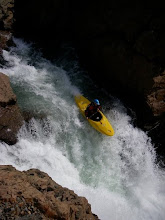Basic Design Concepts:
The longer the kayak, the faster it will be. The wider the kayak, the more stability it will have.
What kind of kayak should I get?
Think about what your goals are in kayaking, and what you feel you are interested in doing with the kayak.
There are three kinds of whitewater kayaks:
1. Creek boat:

Wave Sport Habitat 80
Creek boats are highly-rockered, displacement hull kayaks with round, blunt ends and soft edges. They tend to be voluminous for their length. Creek Boats take their name from the steep creeks they are designed to descend. They are designed be maneuverable, forgiving, and stable even in the most gnarly of whitewater. Their bulbous design is a feature intended to maximize safety, storage, and buoyancy as well as to deflect impacts with river features.
2. River-Runner:

Diesel 80

Fuse 48
River running kayaks are designed for general whitewater use. They are a combination of creek and freestyle kayaks as they share design elements with both. River running designs vary: some designs are larger and faster, more like creek boats (Diesel) and other are shorter, lower volume desings that have more in common with playboats (Fuse).
3. Freestyle:

Project 52
Freestyle kayaks, also known as playboats, are short, low volume, kayaks with planning hulls designed to surf waves and hydraulics. They are usually designed with hard edges and a good amount of kick rocker. They are highly maneuverable but lack downriver speed and stability necessary for navigating technical whitewater.
What size kayak should I get?
Once you know what kind of kayak you want, you will want to look at sizing.
Each kayak has a specified weight range in which the kayak will perform best. Depending on where you are in that weight range, the boat will perform differently. For instance, if you are at the lower end of the weight range for a playboat, it may be hard to throw around, but will be great for river running (more volume available). On the other hand if you are at the higher end of the weight range for a playboat, it will be easy to throw around, but not so great for river running (read: squirly and unstable). If you are on the lower end of the weight range in a creekboat, the boat will be very forgiving and go through anything, but it will probably be somewhat difficult to manuever. If youe on the higher end of the weight range in a creekboat, the boat will be easy to maneuver, but it might be a recipe for disaster in terms of getting stuck in holes. Without the extra volume, the boat won't resurface as quickly and might be "hole-bait." Be careful getting too small a creekboat.
How should the kayak fit?
Once you have the weight range thing figured out, sit in the boat. When in the boat, you want the boat to fit somewhat tightly, but not so tight you cramp up. In general, you want your thigh braces wrapping your thighs completely, but not exerting any downward pressure (this can lead to your legs falling asleep quickly). You want your feet touching the foot brace with your heels together and toes pointed outward. Hip pads should be snug enough so you aren't moving around excessively while your paddling (Hint: If you have plenty of hip pads but the boat still feels "off," try switching the left and right hip pads...its a little different fit, and works well for some people).
Some people choose to use the stock hip pads and foot foam, however if it doesn't work for you, try carving your own from foam.
What's the deal with sizing and colors?
Each manufacturer is different, however the general trend is something like this:
Yellow is the largest (coolest slowest out of the mold), and red is the smallest (it cools quickest from the mold). Blue, Orange and Green tend to be somewhere in the middle and are somewhat hit or miss for size difference. This means if you are borderline to fitting in a boat, go for the color theory. The size difference is not guaranteed but it sometimes it works out.
Finally...
Once you've got the fit thing figured out, sit in the boat and try it out. Outfit it to your specs and see what you think. Each boat is designed a little differently, from deck height to cockpit width, to boat length, etc, and each person has a personal preference of how they like their boat to feel. Go with your gut, and try the boat out on some easy water to see if it's right for you.
Stay tuned for more tips!
Kim Russell

No comments:
Post a Comment